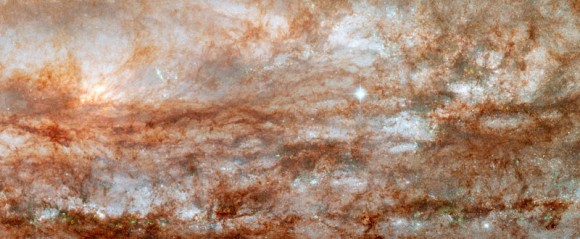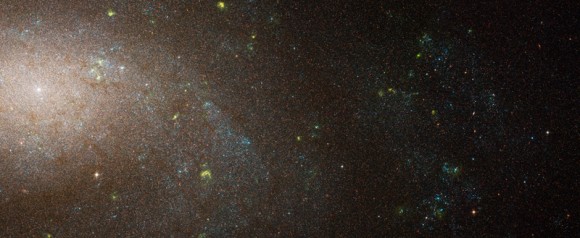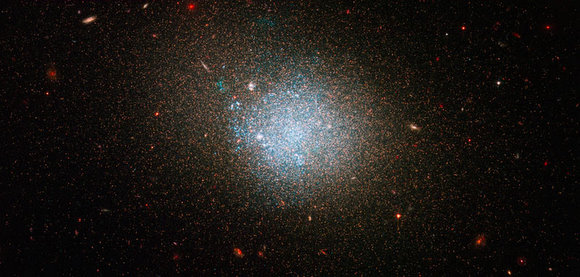[/caption]
Everyone is suffering from severe angst about the fate of the Hubble Space Telescope, and now, on the heels of Hubble’s data controller failure news comes more ANGST. But this is a good ANGST – which is an acronym for ACS Nearby Galaxy Survey Treasury. The Advanced Camera for Surveys (ACS) has completed a thorough survey of galaxies in our cosmic backyard, providing clues about how stars form. Using Hubble, astronomers observed around 14 million stars in 69 galaxies, ranging from 6.5 million light-years to 13 million light-years from Earth. Interestingly, some galaxies were found to be full of ancient stars, while others are like sun-making factories. So, if you’re suffering from Hubble angst, peruse the images from this newest survey – they may bring you comfort. Either that, or you’ll cry from sorrow of what could possibly be lost… (no, no, no — think happy thoughts!!!)…
The detailed survey, called the ACS Nearby Galaxy Survey Treasury (ANGST) program, explored a region called the Local Volume of galaxies. A typical galaxy contains billions of stars but looks smooth when viewed through a conventional telescope because the stars appear blurred together. In contrast, the galaxies observed in this new survey are close enough to Earth that the sharp view provided by Hubble’s Advanced Camera for Surveys and Wide Field Planetary Camera 2 can resolve the brightness and color of some individual stars. This allows scientists to determine the history of star formation within a galaxy and tease out subtle features in a galaxy’s shape.

“Past Hubble observations of the local neighbourhood have provided dramatic insights into the star-formation histories of individual galaxies, but the number of galaxies studied in detail has been rather small”, said Julianne Dalcanton of the University of Washington in Seattle (USA) and leader of the ANGST survey. “Instead of picking and choosing particular galaxies to study, our survey will be complete by virtue of looking at ‘all’ the galaxies in the region. This gives us a multi-colour picture of when and where all the stars in the local Universe formed.”
Many stars in nearby galaxies are the fossil equivalents of new stars forming in the far Universe, and these latest images provide a “fossil record” for stars, providing a better understanding of the masses, structures, and environments of the galaxies.”
Early results of the ANGST survey show the rich diversity of galaxies. Some are made up entirely of ancient stars, while others have been forming stars nearly continuously during their whole lives. There are even a few examples of galaxies that have only started forming stars in the recent past. “With these images, we can see what makes each galaxy unique”, said team member Benjamin Williams of the University of Washington.

The ANGST survey also includes maps of many large galaxies, including M81. “With these maps, we can track when the different parts of the galaxy formed”, explained Evan Skillman of the University of Minnesota (USA), describing work by students Dan Weisz of the University of Minnesota and Stephanie Gogarten of the University of Washington.
“This rich survey will add to Hubble’s legacy, providing a foundation for future studies”, Dalcanton added. “With this information, we will be able to trace the complete cycle of star formation in detail.”
So, check out the images from this survey and all the wonderful, amazing, and incredible Hubble images to help ease your Hubble angst.
Source: HubbleSite


There’s still hope in switch B! Neat pictures.
I’m with Nancy on this one, think happy thoughts! The provided link got me to some very impressive( and massive ) picture files from HST. The November issue of Sky & Telescope had an article on the newly established Hubble Legacy Archive (hla.stsci.edu). Even if Hubble proves unable to provide new pictures(…again, think happy thoughts), this treasure trove of raw HST images along with existing images like the Hubble Heritage pix should provide interested astronomers with terabytes of pure Hubble enjoyment for decades. The HLA site provides tutorials so that anyone with a browser & preferably a broadband connection to access & create their own Hubble masterpieces. Definitely a site to check out for a nearly complete archive of HST images & spectra! And keep thinking happy thoughts, there’s still hope in switch B!
This might provide some crucial information on SN progenitors, just in case a supernova blows in one of these galaxies, we have ultra-deep views in multiple colors of what the region looked like beforehand.
Hubble angst! OK, I get the meaning, but when I read the headline I realized that I DO have angst over Hubble– the very idea of this magnificent scope failing has given me the heebie jeebies– err, angst…
ANGST Survey Galaxy – NGC 253 – I actually do find this image quite soothing.
@Don Alexander – Great point…
I don’t think Hubble angst is too justified. The Hubble has lived way beyond expectations. In fact instead of repairing the thing isn’t it time that a successor was put up there? I think back to the first Hubble repair mission with the great astronaut Storey Musgrave doing spacewalks to repair the thing-and the new era in astronomy this launched. Hubble has had a great run that exceeded expectations. I hope they fix it, but my angst is over the fact that science only gets droplets of funding compared to the pentagon war machine. If we spent $600 billion a year on astronomy imagine the kind of scopes we would have up there in orbit and what we would be learning. Hold your horses-invading Iraq was more important!
David McMahon Says:
September 30th, 2008 at 8:57 pm
“I don’t think Hubble angst is too justified. The Hubble has lived way beyond expectations. In fact instead of repairing the thing isn’t it time that a successor was put up there? ”
A successor will be put up there – JWST in 2013!
Although they are not precisely similar in their capabilities, they are similar enough that it may rightly be named Hubble’s successor.
The problem is, it will not fly until 2013 at the earliest. Which means Hubble is our only ‘eye in the sky’ until then. If Hubble fails before that date, it will be a momentous loss for the astronomical community. Having both flying at the same time would be a massive boon for science, but the best outcome we can probably hope for is that Hubble lives until then. Ergo – angst justified, in my opinion.
But I agree with your last point – my greatest angst is reserved for the lack of funding that science gets. An example – people have often commented to me on what a waste of money it is to build the Large Hadron Collider. When I ask them if they know what it is being built for and what it actually does – they have no idea. But they do know that it cost $10 billion to build, and waste no time in attempting to force me to admit that the money should be spent in other ways. I then mention that for comparative purposes, that kind of money buys slightly less than 3 B-2 bomber warplanes, ex maintenance. It is less than 2% (!!!) of the amount of money congress proposes for the bail out of greedy corporate types on wall street after their latest f-up – all for nothing. And it simply doesn’t even register a blip in comparison to the money required to continue funding the ‘war of terror’ 🙂 raging around the world right now. Not to mention that the LHC is funded by numerous different countries around the world, thereby reducing the financial exposure of any one country.
Science is to important to leave to politicians to decide its future. I’m not sure what the alternative is, but surely it must involve some kind of archaic political system devised through the ages, where scientists rule the world. Either that, or I control everything, which would be much better.
…And when I say ‘science is to important’, I really mean ‘science is *too* important’.
David,
Are you aware of the amount of money (to the nearest billion) which actually goes into science each year? Look at all the colors of money, not just R&D.
What administration has put more money into NASA and other goverment space projects? The same administration which realized several years ago they needed to begin funding a replacement for the Space Shuttle even though the opposition party fought against it being so much money. They wanted to reduce it 20%. In all reality, this should have started during Clinton’s reign.
The current Bush administration has! So how did they finally get the democratic congress to sign off on the extra money for NASA? The adminstration went public in hopes it would spur extra visibility for the space program, by pushing a return to the Moon.
For someone who is ignorant with the space program, and is probably only knowledgeable about some of the more visible projects I guess I can see why you would think this way. Personally, I believe there are more important projects than Hubble fixing something which has a replacement coming.
With adaptive optics and the increase in radio capability, Hubble isn’t exactly the best thing going out there right now… so forgive the scientific community and NASA if Hubble starts falling down the priority ladder. I guess you should also forgive the administration for spending more money on space because of Iraq, eh?
In a related paper posted at the arXiv preprint site for 10-1-08 (“The Recent Star Formation Histories of M 81 Group Dwarf Irregular Galaxies” by Weisz et al [arXiv:0809.5059]) nine dIGs are imaged by HST-ACS & star formation rates and SF histories are derived.These observations also shed light on the SF history of M 81 itself & its’ environs. A link is included to a high-resolution version of the paper, where full-res images of these nine dwarfs can be fully enjoyed. If spiral galaxies formed by accretion of nearby dwarf galaxies, studies such as this will help astronomers tease out the details of this formation. A fascinating paper with great Hubble images to boot! Note that NGC 3077, which is imaged in the above Hubble release and also a member of the M 81 Group is not among the dwarf galaxies studied in the paper mentioned in my previous post.
McEggHeads_BetterHalf Says:
October 1st, 2008 at 4:25 am
“With adaptive optics and the increase in radio capability, Hubble isn’t exactly the best thing going out there right now… so forgive the scientific community and NASA if Hubble starts falling down the priority ladder.”
>I find it highly amusing that you can, in the same paragraph, accuse somebody of not knowing much about the space program, and then go on to spurt the above paragraph out.
Are you honestly equating the capabilities of Hubble with those of ground-based scopes? There are actually good reasons why some astronomers apply for observing time on Hubble, and others on VLT or Gemini or one of the other thousands of scopes in existence – they all have unique capabilities in certain areas that cannot be matched by other instrumentation. Adaptive optics is good, but it still comes nowhere near to reaching the peerless imaging capabilities of Hubble, and likely never will.
And how exactly does an increase in ‘radio capability’ in any way diminish Hubble’s importance? If anything, it makes Hubble all the more important, as often the most exciting discoveries are born out of complimentary observing techniques.
Seriously, for somebody implicitly claiming to know a great deal about the space industry, you seem to demonstrate remarkably little understanding of it. Seems your post was simply a dressed up political rant.
JWST is not a successor to HST, isn’t it? It will not operate in visible wavelength.
If i’m not wrong, it doesn’t see in IR range, as Hubble do.